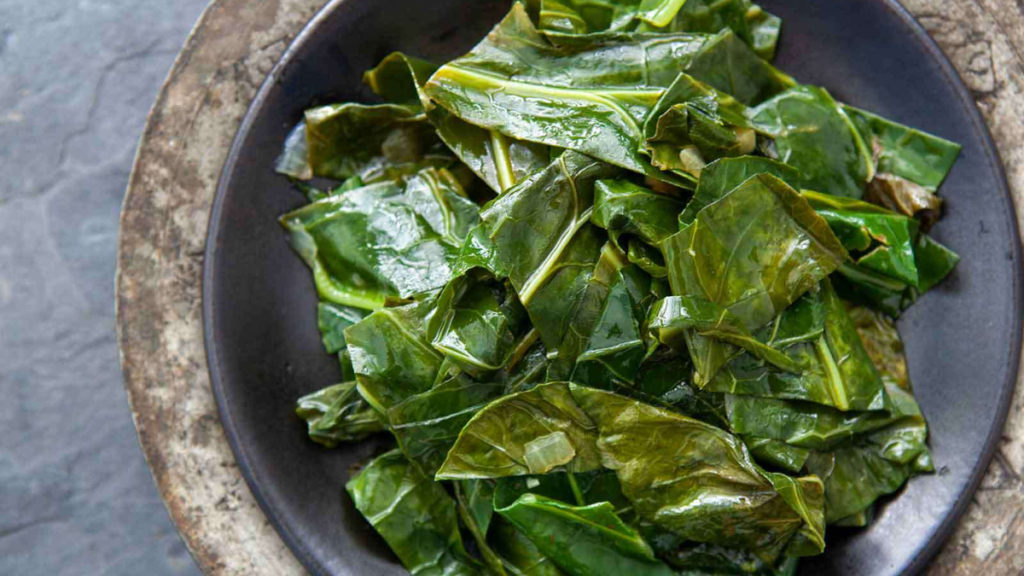Collard greens are incredibly nourishing and have been related to decreasing cholesterol because of their high vitamin K, A, and C content and calcium, iron, and fiber content. They are a hardy green that can persist all year in more temperate climates and well into the beginning of winter in colder ones. But collard greens are the greatest thing ever! These collard greens taste mildly garlicky and lemony and are very wonderful. They are the ideal straightforward and healthy side dish, so I want them now that spring has arrived.
As is customary in Brazil, these collard greens were quickly sautéed in hot oil with some garlic and hot sauce. The traditional accompaniment to these collard greens is “feijoada,” the national cuisine of Brazil, a hearty black bean stew made with pork and served with side rice. These collard greens pair nicely with black beans and rice if you’re a vegetarian or vegan.
What are Collard Greens?
Collards feature robust stems and dark green, fan-shaped leaves. They belong to the same genus of plants as mustard greens, turnips, and kale. They also have a lot in common, are frequently made under the same method (at least in the southern United States, where they are most popular), and use comparable ingredients.
Collards work nicely with ham, beans, okra, and other ingredients in recipes that call for low- and slow-cooking techniques like simmering, braising, or steaming. They aren’t difficult to work with; all they need is a little tender loving care before and during cooking to achieve the perfect texture.
6 Ways to Prepare Collard Greens
For salads: Begin with a large bunch and cut the woody core stems out of them by cutting them in half while slicing along either side of the stem with your knife. Cut the collard halves crosswise into thick ribbons, then stack the halves in a single pile.
Use a paring knife to cut off the stems for wraps. On a flat surface, arrange the collard leaves and top with the prepared filling. Wrap the collard leaves lengthwise around the fillings. Place the wrap seam-side on a serving plate after folding the short ends and rolling one more.
Remove and discard the center ribs from the 2 12 pounds of collard greens before chopping the leaves into 1-inch pieces for sautéing. Collards should be simmered for 15 minutes in a big saucepan of boiling water, then drained in a colander with any excess liquid squeezed out with a wooden spoon. One tablespoon of butter, one tablespoon of olive oil, and two garlic cloves are heated in a sizable, heavy skillet over medium-high heat until foam subsides. The collards are added to taste, along with salt and pepper. Stirring often, cook the collard mixture for 5 minutes or until thoroughly cooked. Combine collard greens with a squeeze of lemon juice.
Steamed: Cut off and discard the middle ribs from 1 pound of collard greens. Leaf parts should be 1 1/2 inches long. 2 inches of water should be added to the bottom of a steamer. Place one minced clove of garlic and the collard greens in the steamer basket—steam for 5 minutes.
Remove and discard the middle ribs after blanching. The greens should be blanched for 2 minutes in a pot of salted boiling water before being drained. Squeeze out the extra liquid once they are cold enough to handle, then let them cool in one layer on a rimmed baking sheet. For up to 4 days, greens can be kept in the refrigerator in an airtight container.
Remove and discard the center ribs from 2 pounds of collard greens before stewing. Leaves should be cut into 1-inch pieces. For about an hour, simmer collard greens in 3 12 cups of chicken broth until they are soft. Add salt and red pepper flakes for seasoning.
Ingredients
- 10–12 glasses of water
- a big or two little smoked ham hocks
- Three garlic cloves
- Collard greens, two bunches
- One big onion, yellow
- Two tablespoons of oil or bacon fat
- Pepper and salt
Equipment
- a large pot or Dutch oven
- cutting board with a chef’s knife
- enormous frying pan
Instructions
- Cook the ham hock slowly. Over high heat, bring the water and ham hock to a boil in a big pot. Add the garlic cloves, stir, and partially cover while lowering the heat to maintain a simmer. Simmer for two hours, checking on the ham hock frequently and adding more water to keep it covered. Prepare the collards in the interim.
- Get the collards ready. With cold water, thoroughly wash the collards. You can remove the middle stem by cutting both of the stem’s sides in half while slicing along its length. Alternatively, you can use your hands to separate the leaves from the stalk. Cut the collard halves crosswise into thick ribbons, then stack the halves in a single pile.
- Slice an onion. Cut the onion into dice.
- Collards must be cooked. Transfer the ham hock to a dish to cool after two hours. Bring the ham broth back to a simmer after adding the collards. Cook collards with a partial cover for at least 45 minutes to get them chewy or up to 2 hours to get them silky-soft. In the interim, shred the ham.
- Cook the onion while shredding the ham. Discard the rest of the ham hock after shredding the meat. Heat the bacon fat or oil over medium heat in a big frying pan. Add the onion and simmer for about 15 minutes until shiny and soft. As soon as the onions begin to brown, add the ham and continue cooking. When the collards are cooked, remove them from the heat and reserve them.
- Mash up and sauté. Turn off the heat when the collards are finished cooking. Using tongs, transfer the collard greens from the pot to the pan with the onions. Include the garlic, which will be soft and simple to smash into the collards. Splash a few spoons of the cooking liquid toward the end to moisten the greens as you continue to sauté over medium heat until all the flavors have melded. Add kosher salt and several grinds of fresh pepper to taste. Serve them!
Where to Buy Collard Greens?
Collards are typically easy to find because they are offered year-round in most supermarkets or marketplaces that cater to African-American communities. The next kale, Swiss chard, and other lush green vegetables are kept produce department t refrigerated and stocked in bunches. Given their size, the leaves are difficult to ignore.
Farmers’ markets are another place to find collards, but wherever you get them, seek collards with solid stalks and crisp, green leaves that are big and sturdy, almost like you could use them as a fan to cool yourself off in the heat. Anything yellowing and withering are already past its prime, so avoid it.
What do Southern Collard Greens Taste Like?
One of my first questions is “Really,” when folks say they don’t like collard greens. Then how were they created? I’ve won over a fair number of collard greens haters with this dish. They had only ever eaten collard greens raw, sautéed, or boiled in water, as you can see. Collard greens served in the South are a different creature and tasty!
This dish for collard greens is bursting with flavor! It has a mild heat, is smokey, salty, vinegary, and incredibly flavorful. After cooking in the flavorful broth for a while, the greens are incredibly delicate. Collards have a strong flavor and a rough texture on their own. But the more you cook them; the more their flavor will mellow and become milder.
Health Benefits of Collard Greens
All green vegetables are nutrient-dense, but dark green veggies are healthier because they have more chlorophyll. Vitamins, minerals, and other nutrients that support your health are found in chlorophyll. Fresh collard greens are one of the healthiest vegetables available.
Collard greens have high fiber content and are a rich source of bone-building vitamins A, C, E, and K. Iron, calcium, magnesium, and potassium are also abundant in them.
How to Clean Collard Greens?
Cleaning the leaves is a tedious but crucial step in the preparation of collard greens. The cleanliness of your greens may likely vary depending on where and how you get them. This is because grit and filth can easily collect on sturdy stems and high veins. Cut the roots off your collard greens before washing them.
- The greens should be submerged in a sizable dish of cold water.
- To help the grit come loose, spin them around. Drain in a colander.
- Once the water remains clean, continue this procedure with the filthy water.
Fresh collard greens shouldn’t be washed before being stored since you want to keep them as dry as possible. For up to a week, store the greens in the refrigerator’s crisper drawer in an airtight plastic bag or container.
- Never wash. Greens should not be rinsed before storage.
- Seal. Put the leaves in a Glad Food Storage Zipper Bag and close it, sucking out as much air as possible.
- Refrigerate. Place the bag of greens in the refrigerator’s crisper drawer.
Additional Tips
Unwashed collard greens should be stored in the refrigerator in a plastic bag to maintain their crispness. They shouldn’t be washed before being placed in the refrigerator because doing so will hasten their deterioration.
Collards can last up to five days, depending on how fresh they were when you got them. Anything you purchase from a local farmers market typically lasts twice as long.
Blanching sounds elegant, but it merely entails submerging the greens in boiling water for three minutes before freezing. After that, please put them in ice water to stop the cooking. Drain and pat dry. Chop the greens and freeze them for up to a year in a plastic bag that can be sealed.
Nothing prevents you from freezing collard greens in their raw state, but blanching them will maintain their quality and nutritional value because it stops the enzymes that could cause spoiling once the food is frozen.
Collards are a type of vegetable with broad, dark-green leaves and tough stems that must be cut away before consumption. Collard greens are the edible leafy portions. They are prepared similarly to cabbage, kale, and mustard greens and are closely related to them. Collard greens are a common side dish in Southern cooking and are renowned for their heft.
Cooking techniques for collard greens include adding smoked and salted meats (bacon and ham hocks are popular options), onions, vinegar, pepper, and salt. Because the tough leaves hold up well to prolonged cooking, they are frequently used in braises and soups. They can also be found in salads or wraps that employ greens instead of bread.

